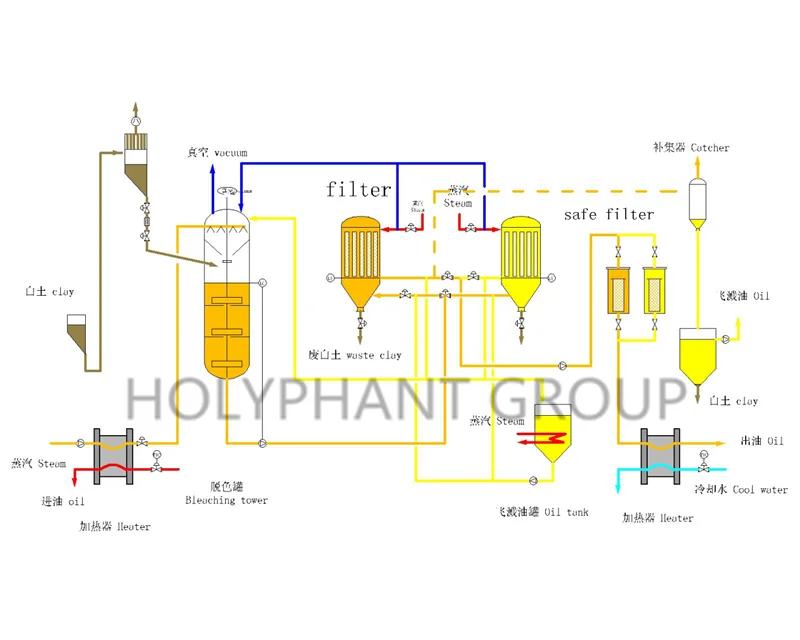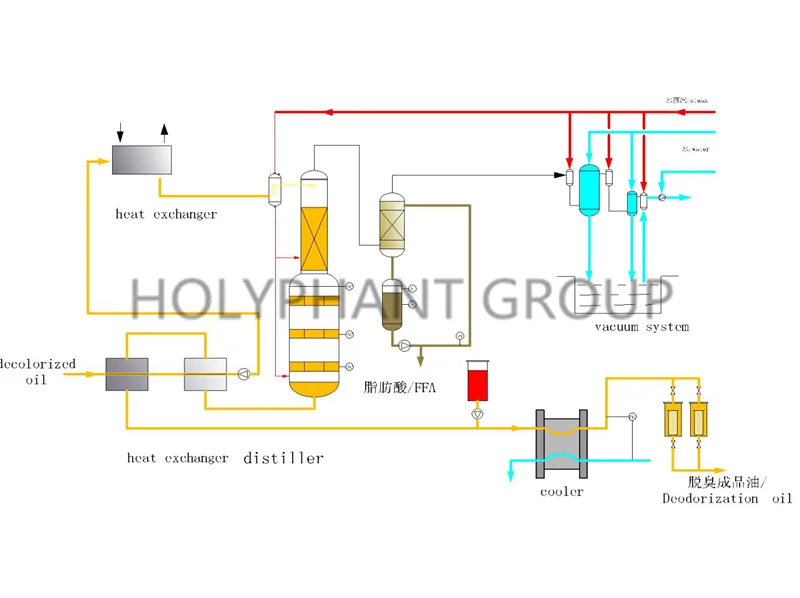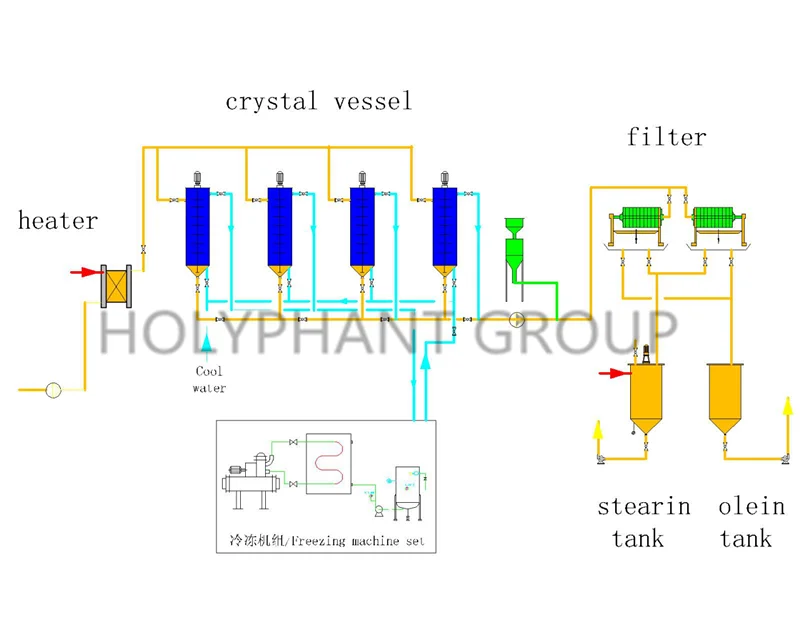High Technology and Rich Experience Cooking oil Refinery Equipment
oil refinery equipment
crude oil refinery equipment
vegetable oil refinery equipment
Degumming and pre-bleaching Section:
The line adopts the SiO2 absorbing technology, which absorbs the gums, metal ion,pigment, etc. It could reduce the consumption of bleaching clay, reducing the lose in bleaching.
Remove solubility impurity in the crude oil is degumming process. Because phospholipid is main part of solubility impurity in the crude oil. In industry, degumming also is named ridding of phospholipid. If the biodiesel has more gums,which would effect the firing,block the injector,etc.
Main process: The Crude oil filtered is pumped out from the Buffer Tank. Passing through dosing system, to enter into the mixing vessel and to be Heated up to designed temperature 80℃. Then to put into the the phosphoric acid 0.2% orso, to change the non-hydrated phospholipids into hydrated phospholipids. The mixture in the vessel reacts for 10-20 mins. Then put into the mixer vessel for mixing with the SiO2 (0.05% of oil) added via the metering Pump, which mixing for 15 mins orso.
Then pump into the vacuum drying tower for removing out the moisture.
Filter system
At last use one filter to get the degummed oil for pumping into the bleaching vessel. The waste SiO2 is washed for recovery.
Vacuum Drying:
There is still little quantity of water in oil . therefore send the oil into the Vacuum Drier to remove the water in oil. Liquid level in the Vacuum Drier is controlled by floating ball. Pump out oil in the Vacuum Drier by Canned Pump.

Pre-Decolorizer process
It adopts the vacuum bleaching method, which use 0.8% active clay is enough .
Pump the oil degummed into decolorizer vessel, samely open the vaccum system to rise its temperature to remove off the balance mositure, the temperature is 115 degrees, to put into the mixture of crude oil and clay, mixing for 30 mins, then reduce the temperature to 70 degrees, and close the vacuum and filter the clay with oil filter, to get the oil decolorized.
Note: This process could remove out 40% red color, the more is removed out from the distilling process.
Main process: the oil degummed is pumped into the decolorizer, samely open the vacuum system to rise its temperature to remove off the moisture firstly.
The clay dosed flow into the mixing tank/clay and oil firstly, then inhaled into the decolorizer vessel with the vacuum condition, which mixing for 10 mins or so under the 110 degrees and vacuum condition, after cooling(the decolorizer vessel has the water coil for cooling oil), the temperature to 70 degrees or so, which flow into the leaf filter for remove off the clay and oil go to the next process.
The bleaching tower adopts circulation steam mixing technology, whose advantages are:
1) Advanced steam mixing technology, excellent stirring results, mixed evenly, good decolorizing effect and the strong adaptability.
2) In the absence of mechanical agitation, good equipment sealing performance, and no power consumption, stirring uniform and effective to avoid oil movement shortcircuit in the tower, concise efficient structure, operation and maintenance is very convenient, no need to replace wearing parts, and complete machine weight and load of tower Lower, is not high to the foundation request, the control arrangement is reasonable, easy to install.
3,Scaling tower is not easy, easy cleaning. Long life, low cost.
4. The liquid Level controlling device is installed, to ensure working continuous, safe operation, make the human factors reduce to a minimum.
Data of bleaching oil
P < 5ppm; Fe ion < 0.1ppm, Cu < 0.01 ppm

Distilling Section:
Distilling process not only remove the fetid impurity, increase oil smoke point,make better taste, but also improve oil stability, quality and chroma. At the same time,we can get rid of free fatty acid, peroxide, heat-sensitive coloring matter, protein in the mucid oil cake, polycyclic aromatic hydrocarbon ,and residual pesticide residue. In the oil process, we always emphasized deodorizer
The standard bleached oil enters into Heater, Heat Exchanger, and Heater, and the oil is heated to process temperature (240-260℃). Subsequently pump the oil to Deodorizer. The deodorizer is combined type: the upper is packed type to remove the producing components such as free fatty acid; the bottom is plate type to remove out the odor and get hot bleaching effect. Oil from the Deodorizer enters into the condenser to recover most of the heat and makes further heat exchange. Finally the oil is cooled to 80-85 ℃ by Cooler. Volatile from the deodorizing system is separated by FFA Scrubber. The separated liquid is FFA at 40-50 ℃.

Fractionation of oils and fats process
Dry fractionation of oils and fats is the separation of high-melting triglycerides from low-melting triglycerides by crystallization from the melt. Apart from blending, it is the cheapest process in oils and fats processing. It is a pure physical process compared to other chemical modification processes such as hydrogenation and inter-esterification which modify triglycerides. Dry fractionation is now applied to many kinds of fats: palm oil, anhydrous milk fat, tallow, fish oil, lard, cottonseed oil, sunflower seed oil, palm kernel oil, tallow butter fats, and special fats.
The most important applications are: palm olein used extensively as frying oil, palm super olein as salad oil and frying oil, the palm-mid fraction as component of cocoa butter equivalent, palm kernel stearin as cocoa butter substitute, anhydrous milk fat fractions for bakery and confectionery products, spreadable butter, tallow olein for frying oil and spreads. In this process, the fat is melted and heated to eliminate any crystal memory. The molten fat is cooled down under controlled agitation and cooling conditions to produce crystals nuclei formed by the higher melting triglycerides. Then, nuclei will grow to form crystals of the desired size. When the crystallisation has progressed far enough, the slurry is separated.
The final oil could be separated into 18 degrees, 24degrees, 33degrees according to melting degrees.
Crystal Filter
This line adopts use two sets plate filter with automatically controller, so it could work better and save the labor.
Membrane filter press plate by diaphragm plate and the chamber arrangement of the composition filter chamber,the conveying pump slurry under pressure to enter the filter chamber through the filter media( filter cloth ) in the slurry of solid and liquid separation, when the slurry in solid form after the cake, again through the diaphragm into the air, the filter press room full of solid, lower moisture content, Filter for viscous materials require a higher moisture content and for users of this machine have their unique characteristics.
Plate with enhanced molded polypropylene, polypropylene plate with diaphragm mounted together, sturdy, secure, easy off, long service life. Specially used for the veg oil and fats fractionation.
